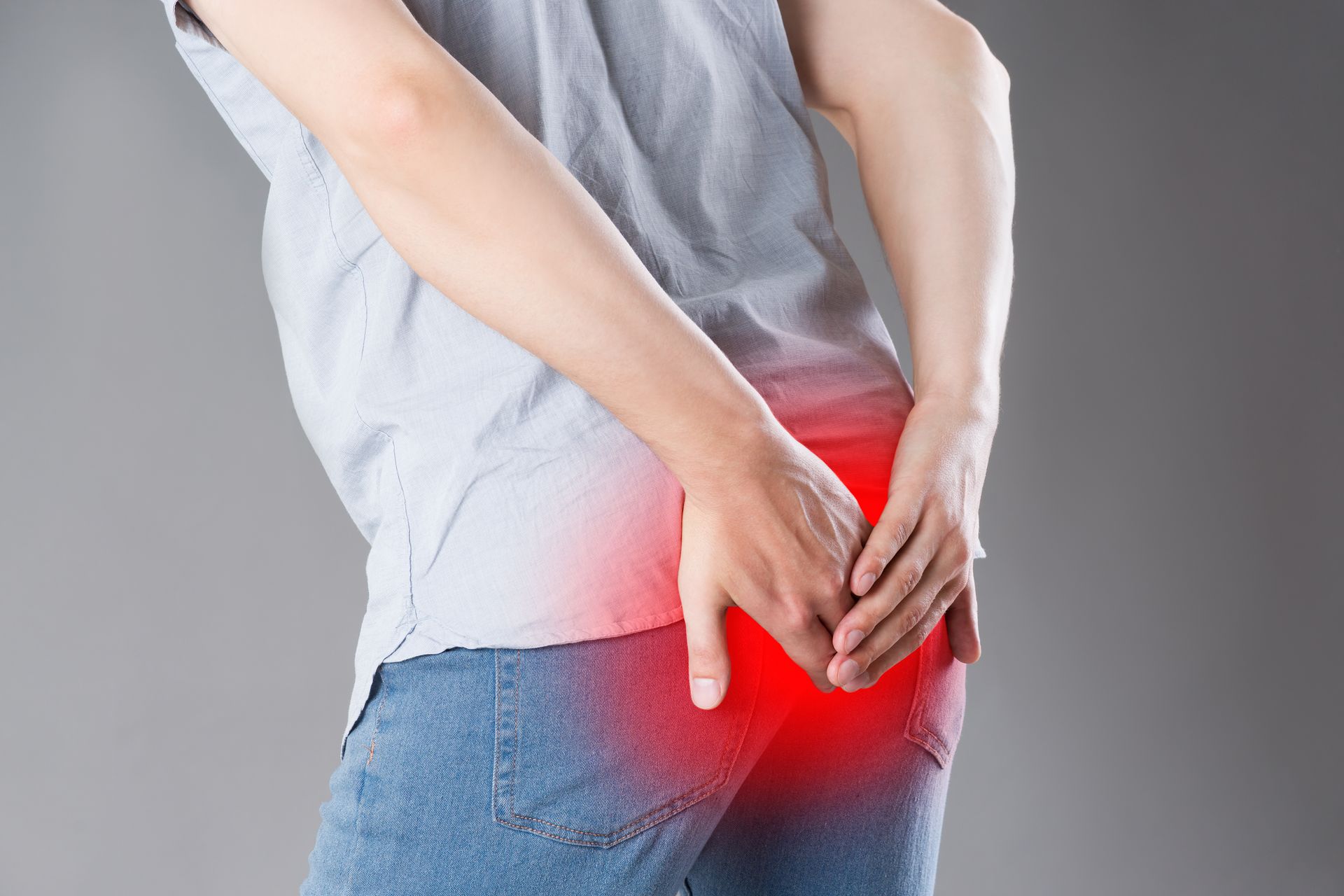Living with Pilonidal Disease Daily Discomfort: Tips for pain relief, hygiene, and lifestyle
Facing daily discomfort near the tailbone can feel isolating, but small changes often bring real relief.
This short guide helps you manage symptoms day to day while you plan definitive treatment. It explains simple steps to keep the area clean, cut pressure, and ease pain.
Early attention matters: prompt care shortens how long you live with symptoms and lowers the chance of bigger problems.
Read on for practical tips — sitz baths with a few teaspoons of Epsom salt, hot compresses, cushions, posture adjustments, clothing choices, and safe medication practices.
Pilonidal Fix is the only dedicated practice in the Northeastern US focused on this condition. Led by Dr. Rafailov, they offer expert care, direct communication, and the highest cure rate. Call 973-323-2400 or visit www.pilofix.com for specialized help.

Key Takeaways
- Small daily steps can reduce pressure and ease discomfort.
- Warm sitz baths and hot compresses often soothe symptoms.
- Keep the area clean, dry, and free of coarse hair.
- Use cushions and posture changes to limit prolonged sitting.
- Never pop a cyst; follow prescribed antibiotics and pain meds.
- Contact a specialist early — delays can lead to complications.
- If you are in the Northeast US, Pilonidal Fix and Dr. Rafailov provide focused treatment.
What a pilonidal cyst is and why daily management matters right now
A pilonidal cyst forms near the tailbone in the crease between the buttocks. It is a small pocket where hair and debris can collect and may develop into an inflamed sinus that drains or becomes painful.
Common cause pilonidal factors include coarse hair, sweat, friction, and prolonged sitting. These issues raise the risk of infections and repeated flare-ups.
Daily steps matter because early care shortens how long you live pilonidal symptoms and lowers complication risk. Simple actions—good hygiene, pressure relief, and hair control—help keep the area stable while you plan treatment.
- Keep the place clean and dry.
- Limit long periods of sitting and change your position often.
- See a doctor early to confirm diagnosis and discuss treatment pilonidal.
Pilonidal Fix focuses exclusively on pilonidal disease and can tailor daily management until you get lasting care.
Call 973-323-2400 or visit www.pilofix.com to connect with Dr. Rafailov.
| Issue | Daily Fix | Why it helps |
|---|---|---|
| Hair in region | Trim or remove gently | Reduces debris that can enter the sinus |
| Prolonged sitting | Use breaks and cushions | Lowers pressure and irritation |
| Early drainage | Clean, dry, and call doctor | Prevents larger infections and saves time |
Living with Pilonidal Disease: setting expectations for day-to-day life
Managing symptoms starts by knowing where the problem sits and what makes it flare.
Where it occurs: Expect the issue to center on the tailbone and coccyx area, right in the crease of the buttocks. This region traps hair and moisture, which can irritate the skin and form a small cyst.
Why symptoms flare: Most flare-ups follow simple mechanics: loose hair or hair entering tiny pits, friction from tight clothes, sweat that keeps the skin damp, and long periods of sitting that raise local pressure.
- Day-to-day life often gets harder after long drives or desk shifts—plan micro-walks and seat breaks.
- Loose, breathable clothes cut down rubbing and reduce chances of infections.
- Notice patterns: mild swelling or tenderness after certain activities means you can adapt routines to reduce risk.
- Keep a small kit (soft wipes, spare underwear, towel) for quick care when needed.
Realistic outlook: Good self-care and pressure control can calm symptoms, but a chronic sinus usually needs medical evaluation. Pilonidal Fix offers patient education and tailored plans until definitive care is arranged. Call 973-323-2400 or visit www.pilofix.com.
How to relieve pain before treatment
Quick, safe steps can ease tailbone pain while you wait for medical care. Start a routine that reduces pressure and calms the skin. These measures help until definitive care or surgery is arranged.
Warm sitz baths and Epsom salt soaks
Fill a basin with comfortably warm water and add 3–4 teaspoons of Epsom salt. Soak for about 20 minutes to soothe the sinus and ease pain.
Make sure the water is warm, not hot, to avoid irritating the skin. Pat the area dry and rinse away any soap residue afterward.
Hot compresses and short relief
Apply a hot, wet compress a few times per day to lessen pressure and itching between soaks. Use gentle pressure and limit each application to 10–15 minutes.
OTC options and cushions
Over-the-counter pain relievers may help; follow label directions and avoid doubling up on active ingredients.
Sit on a coccyx or donut cushion to reduce pressure during work or driving. Do these steps every day until you see a specialist.
- Do not pop or squeeze a cyst — call a clinician if pain spikes, drainage increases, or fever develops.
- Pilonidal Fix guides safe at-home relief while arranging definitive care. Contact Pilonidal Fix: www.pilofix.com | 973-323-2400.
Hygiene habits to reduce infections and irritation
Small, repeatable hygiene steps make a noticeable difference for tender areas. These habits protect the skin and reduce the chance of infections while you plan longer-term care.
Daily gentle cleansing
Make sure to cleanse the area every day using a mild soap and warm water. Rinse thoroughly so no residue remains to irritate sensitive skin.
Keep the skin dry and avoid harsh products
After washing, pat the place dry gently; do not scrub. Avoid alcohol-based or heavily fragranced products that can inflame the skin and raise infection risk.
Post-wash care and hair control
Build a simple routine: quick morning rinse, pat dry, and a midday check if you sweat or sit for long periods. If hair tends to collect, discuss depilatory creams or other options with your clinician.
- Carry unscented wipes for on-the-go freshness after workouts or long commutes.
- Launder underwear and towels often to lower bacterial load on the area.
- These small steps, done every day, can make living pilonidal sinus management a little bit easier.
Pilonidal Fix emphasizes repeatable hygiene that protects the place and keeps symptoms calmer. For expert guidance, visit www.pilofix.com or call 973-323-2400.
Minimizing pressure on the coccyx during your day
Simple shifts in how you sit and move make a big difference for comfort around the coccyx. Reduce direct pressure, change positions often, and choose softer seats when you can. Small steps protect the sensitive area and lower irritation across the day.
Limit prolonged sitting and take movement breaks
Set a timer to limit sitting blocks to 30–45 minutes. Stand, stretch, or walk for a few minutes to unload pressure from the tailbone.
Use cushions and adjust posture to shift weight
Bring a coccyx cutout or donut cushion to work, class, or while driving. A soft cushion reduces direct pressure on the area and helps when seats are hard. Lean slightly forward at the hips and keep feet flat to change your position and distribute weight more evenly.
Pick softer places and adapt when you can’t control seating
Choose the softest available seat and add a folded towel or portable cushion if needed. For long drives, tilt the seat pan and use lumbar support; bring your cushion for extra protection.
Pilonidal Fix can help tailor workplace changes and routines to protect the coccyx. Call 973-323-2400 or visit www.pilofix.com for practical guidance.
Clothing choices that help, not hurt
How you dress can lower friction and help the area stay dry and comfortable. Pick outfits that reduce heat, rubbing, and tight seams. Small changes cut irritation and make sitting easier during recovery.
Loose, breathable fabrics to reduce friction, sweat, and heat
Choose fabrics that let air move and avoid trapping moisture. Soft cotton and moisture-wicking blends are good options. Steer clear of rough or synthetic materials that hold sweat and raise friction.
- Choose loose, breathable clothes so the skin stays cooler and drier.
- Avoid tight waistbands, rough seams, and styles that add pressure across the area.
- Rotate airy underwear; skip thongs or tight briefs that rub the crease.
- Change out of sweaty workout gear quickly to limit moisture exposure.
- Carry a portable cushion for commuting or long office days to reduce direct pressure.
- Consider tagless pieces and flat seams to minimize rubbing on the region.
Pilonidal Fix recommends these simple outfit swaps to minimize friction and help you feel more comfortable. Call 973-323-2400 or visit www.pilofix.com for tailored advice.
Hair removal strategies to prevent hair entering the sinus
Targeted hair control lowers the chance that loose strands will migrate into the crease. Focus on the immediate area and the adjacent skin where hair tends to collect. Removing hair carefully can reduce irritation and recurrence.
Discuss depilatory creams or laser options with your doctor
Depilatory creams may work well for short-term removal but can irritate sensitive skin. Always patch-test a small area first and follow directions exactly.
Laser hair removal can cut long-term hair growth. Ask your clinician to discuss doctor suitability based on skin type, cost, and maintenance needs.
Timing and technique to minimize irritation of the skin
Do hair removal only when the skin is calm. Avoid any method during active redness, swelling, open drainage, or infection.
- Trim long hair first so removal methods cause less tugging.
- Never remove hair over open wounds or draining tracts.
- Keep the area clean and dry after removal to reduce folliculitis risk.
- Reassess frequency with your clinician; laser may reduce how often hair entering the crease becomes a problem.
| Method | Benefit | Precaution |
|---|---|---|
| Depilatory creams | Quick and inexpensive | Patch-test; avoid if skin is sensitive |
| Trimming | Reduces bulk and tugging | Use clean, sharp tools; trim dry hair gently |
| Laser removal | Long-term hair reduction | Requires multiple sessions; discuss skin type first |
Staying active without aggravating the area
Gentle movement can help healing while avoiding activities that press on the coccyx. Keep routines that boost circulation and cut down on direct pressure.
Low-impact movement: walking and gentle activity over sit-ups
Favor low-impact options such as walking, swimming, or easy cycling on a well-cushioned seat. These keep blood flowing without loading the coccyx.
- Replace sit-ups with planks or side-lying leg lifts to protect the tailbone.
- Use a gel or foam saddle cover for short bike rides to reduce pressure.
- Warm up, cool down, and change out of damp clothes promptly to avoid chafing.
Avoid heavy lifting and high-friction workouts around the tailbone
Avoid heavy lifting, intense spin sessions, rowing without pads, and any high‑friction drills that rub the crease.
"If an activity causes rubbing, stinging, or throbbing, stop and modify it."
- Break up sitting every 30–45 minutes to limit prolonged sitting and relieve pressure.
- Keep hair managed if it mats after workouts, and shower soon after to protect the skin in the area.
Pilonidal Fix provides activity plans that support healing while keeping you moving. Call 973-323-2400 or visit www.pilofix.com to get a tailored plan for each day and to protect your life pilonidal balance.

Medication and self-care do’s and don’ts
Smart medication use and simple self-care choices reduce pain and lower infection risk.
Take prescribed antibiotics and pain relievers exactly as directed
Follow your doctor’s instructions and finish the full antibiotic course if one is prescribed. Take pain medicine on the schedule advised so discomfort stays controlled and you can move comfortably.
Don’t pop the cyst and avoid risky DIY steps
Do not squeeze or lance a cyst at home. Prying at a draining sinus can push hair and debris deeper and raise infection risk.
- Do not mix over-the-counter meds without checking labels or asking a clinician.
- Use a cushion to lower pressure while seated so medications can work better.
- Watch for side effects like rashes, stomach upset, or new pain and report them.
- Avoid harsh antiseptics or alcohol on sensitive skin unless instructed.
Pilonidal Fix stresses safe at-home care and timely clinician contact. For expert guidance, visit www.pilofix.com or call 973-323-2400.
When to call a doctor and consider pilonidal cyst treatment
Know the warning signs so you can get care before a small issue becomes a major problem. Watch the tailbone and coccyx area and track any changes in pain, drainage, or skin appearance.
Red flags to act on now
- Spreading redness or increasing swelling around the place near the tailbone.
- Pus, foul drainage, or a sudden rise in pain that limits movement.
- Fever, chills, or a general sense of being unwell with local symptoms.
Why prompt care matters
Delaying evaluation can let the sinus enlarge and form branching tracts. That often turns a straightforward case into one needing more complex cyst treatment.
If infections recur or drainage happens frequently, it is reasonable to discuss doctor-recommended options for a more definitive treatment plan. Describe the exact place, how long symptoms last, and their severity to help your clinician decide how urgent the visit should be.
Pilonidal Fix: expert care in the Northeastern US for lasting recovery
If you need focused, regional care, a specialized practice can change the course of chronic symptoms.
Pilonidal Fix is the only clinic in the Northeastern US devoted solely to pilonidal disease. The team offers precise diagnosis, modern surgery options, and a clear plan for lasting results.
Patients get practical guidance on daily comfort. That includes hygiene, pressure relief with a cushion, safe hair removal, and step-by-step wound care before and after any procedure.
Contact Pilonidal Fix: www.pilofix.com | 973-323-2400 — Dr. Rafailov, New Jersey specialist
- Focused care: individualized cyst treatment plans based on anatomy and history.
- Surgical options: modern approaches that lower recurrence and speed recovery.
- Clear communication: direct access to your doctor and compassionate follow-up.
- Convenience: tele-consults and streamlined scheduling for patients across the region.
Conclusion
Small, steady daily habits can ease symptoms and help you plan lasting care.
Keep the area clean and dry, use warm sitz baths or hot compresses for pain, wear loose breathable clothes, and use a cushion to cut pressure during long sitting. Trim or discuss hair removal options, including depilatory creams, with your doctor before trying them.
Do not pop or squeeze a pilonidal cyst or sinus. Take prescribed meds as directed and seek prompt care for spreading redness, fever, or heavy drainage. Conservative routines help day-to-day comfort but do not replace formal treatment.
Pilonidal Fix offers high‑cure‑rate care and clear guidance from Dr. Rafailov. For specialized help in the Northeastern US, visit www.pilofix.com or call 973-323-2400. Last updated: contact the office for current scheduling.
Frequently Asked Questions About Living with Pilonidal Disease
What is a pilonidal cyst and why does daily care matter?
A pilonidal cyst is a small pocket or sinus that forms near the tailbone, often containing hair, debris, and trapped fluid. Daily care reduces pain, lowers infection risk, and can prevent flare-ups that lead to abscesses or surgery.
Where does this condition usually occur?
It typically forms in the crease between the buttocks near the coccyx (tailbone). The deep cleft there collects sweat, hair, and pressure, which can cause irritation and sinus formation.
What triggers flare-ups or infections?
Hair penetrating the skin, friction from tight clothes, prolonged sitting, excess sweating, and poor hygiene all raise the chance of inflammation and infection.
How can I relieve pain at home before seeing a doctor?
Try warm sitz baths with Epsom salts to soothe the area and encourage drainage, apply hot compresses for short periods to ease pressure, and use over-the-counter pain relievers as directed. A coccyx or donut cushion can also reduce sitting pain.
Are sitz baths effective and how often should I do them?
Yes. Warm sitz baths for 10–20 minutes once or twice daily help reduce swelling and discomfort and promote drainage when present. Keep sessions consistent until you see a clinician.
What hygiene steps reduce infection and irritation?
Clean the area daily with a mild, fragrance-free soap, rinse thoroughly, and pat dry. Avoid aggressive scrubbing, alcohol-based products, or harsh antiseptics that damage skin and delay healing.
Should I keep the area dry or moist after cleaning?
Keep it dry. After washing, gently pat the area dry and allow it to air for a moment. Moist, occluded skin can increase infection risk and friction-related irritation.
How do I avoid putting pressure on the coccyx during the day?
Limit prolonged sitting, stand or walk every 20–30 minutes, use a supportive coccyx or donut cushion when seated, and favor softer surfaces or good ergonomic chairs to redistribute pressure.
What clothing choices help reduce symptoms?
Wear loose, breathable fabrics like cotton or moisture-wicking blends. Avoid tight jeans, athletic gear that rubs the crease, and rough seams that increase friction and heat.
Can hair removal prevent hair from entering the sinus?
Yes. Removing hair around the cleft reduces the raw material that can penetrate skin. Discuss options with your doctor — shaving, depilatory creams, or laser hair removal each have pros and cons for irritation and recurrence.
Are depilatory creams safe to use near the tailbone?
They can be effective but may irritate sensitive or inflamed skin. Test on a small area first and consult your clinician before regular use, especially after recent drainage or surgery.
How should I time hair removal to avoid irritation?
Avoid hair removal during active infection or severe inflammation. When the area is calm, use gentle methods and space sessions to allow skin to recover. Laser treatment requires a provider visit and usually offers longer-term reduction.
Can I stay active without making things worse?
Yes. Low-impact activities like walking or swimming are usually fine. Avoid exercises that press directly on the tailbone (e.g., sit-ups, heavy weightlifting) or cause repetitive friction until healed.
What medications or self-care should I follow?
Take prescribed antibiotics and pain medicines exactly as directed. Use topical wound care per your clinician’s instructions. Do not attempt to lance or pop a cyst yourself; that raises infection and scarring risk.
When should I call a doctor?
Seek care promptly for increasing redness, swelling, pus drainage, fever, worsening pain, spreading streaks, or if you can’t manage symptoms at home. Early treatment lowers complications and may prevent more invasive procedures.
What complications happen if treatment is delayed?
Delay can lead to repeated infections, larger abscesses, sinus tract formation, chronic drainage, deeper tissue involvement, and a higher likelihood of needing surgical excision.
Are cushions and posture changes really helpful?
Yes. A coccyx or donut cushion reduces direct pressure on the cleft, while posture changes and standing breaks limit friction and blood pooling that worsen symptoms. These simple steps often improve comfort quickly.
Who should I contact for expert care in the Northeastern US?
For specialized evaluation and lasting recovery, contact Pilonidal Fix at www.pilofix.com or call 973-323-2400 to reach Dr. Rafailov, a New Jersey specialist in this condition.





